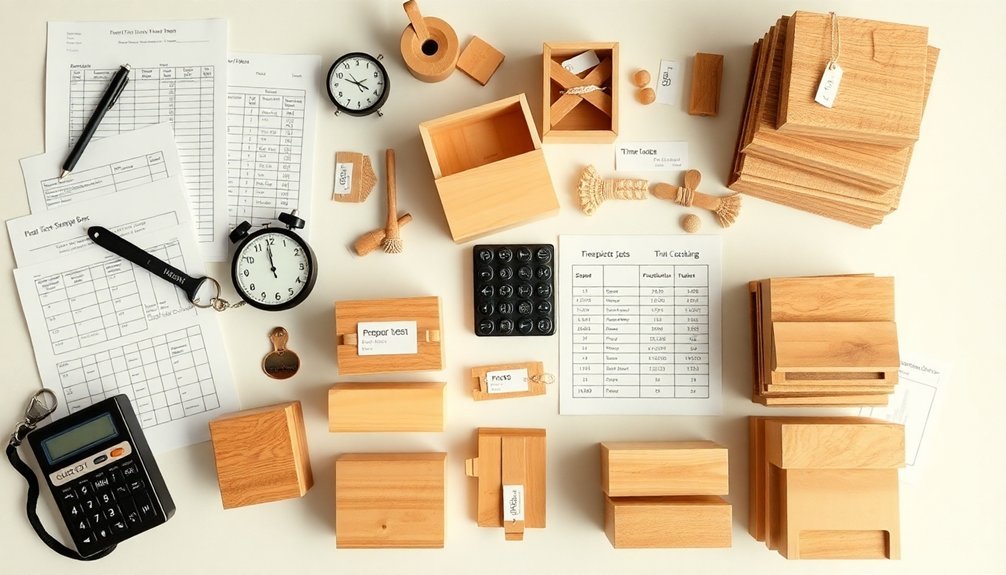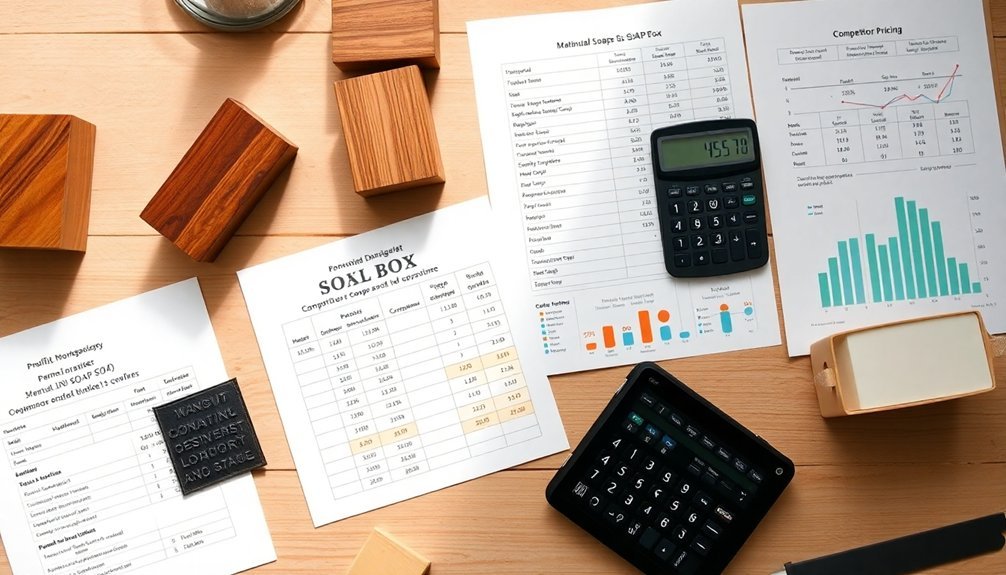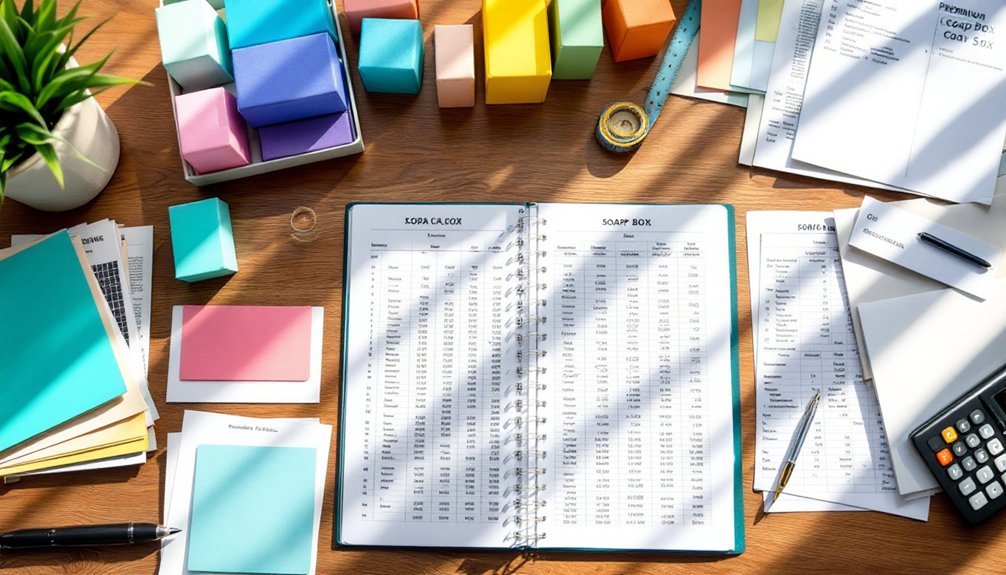To calculate soap box costs accurately, you'll need to track five key elements: 1) raw materials including boxes, labels, and protective wraps, 2) labor hours for assembly and quality control, 3) overhead expenses like rent and utilities (typically 15% of total costs), 4) detailed packaging component breakdowns, and 5) market-based pricing comparisons. Don't forget to factor in eco-friendly options that might command premium pricing. These calculation methods will transform your pricing strategy and boost profitability.
5 Best Methods To Calculate Soap Box Costs

When you're launching a soap business, understanding your true production costs is crucial for pricing your products profitably.
Start by calculating the cost of materials, including raw ingredients, additives, and packaging materials like boxes and labels.
Don't overlook production supplies such as gloves and pipettes—estimate their cost based on usage per batch.
Calculate labor costs by tracking time spent on each production step and applying the appropriate hourly wage, including taxes.
Finally, factor in overhead expenses like utilities and workspace rental. These can be calculated as a percentage of your total cost to guarantee you're capturing all aspects of production.
Material Cost Breakdown Analysis for Traditional Soap Packaging
Although often overlooked by new soap makers, packaging costs can greatly impact your product's profitability and must be carefully itemized. When calculating your soap's retail price, consider that boxes typically cost $0.30-$1.00 each, depending on quality and design complexity.
Labels add another $0.10-$0.50 per unit, varying based on printing method and adhesive quality. Don't forget protective wraps or moisture-absorbing packets, which add $0.05-$0.20 per bar but enhance product longevity.
To accurately determine your profit margin, total all packaging materials—boxes, labels, inserts, and additives. This thorough analysis guarantees you're not underpricing your product.
Labor and Production Time Assessment for Handcrafted Soap Boxes

Since labor often represents the largest expense in handcrafted soap box production, you'll need to meticulously track all time investments to establish accurate pricing.
Calculate your true cost per box by multiplying production time by the hourly wage of your team members.
- Track each packaging step separately—cutting, folding, labeling, and quality checks—to identify which processes consume the most resources.
- Don't forget to factor overhead costs, including benefits and applicable tax laws that increase your actual labor expenses.
- Implement SOPs to standardize handcrafted soap box assembly, potentially reducing production time and increasing efficiency.
- Review your labor tracking data regularly to spot opportunities for process improvements that could lower costs while maintaining quality.
Overhead Expense Allocation for Small-Batch Packaging Operations
Beyond direct materials and labor, your overhead expenses can quietly erode profitability if you're not tracking them methodically.
For small-batch soap packaging operations, allocate approximately 15% of total product costs to utilities, workspace rent, and insurance.
Distribute these overhead expenses proportionally based on production volume, ensuring each soap box carries its fair share.
Track packaging time to accurately determine labor cost contributions to your overhead calculations.
When pricing your soap, regularly review and adjust overhead allocations as your production levels change. This practice maintains competitiveness while preserving margins.
Don't overlook marketing expenses—consider allocating about 20% of operating expenses to marketing during growth phases to boost brand visibility.
Market-Based Pricing Strategy for Artisanal Soap Containers

While managing your overhead costs forms the foundation of pricing, the market ultimately determines what customers will pay for your soap packaging. Implementing an effective market-based pricing strategy requires balancing your raw materials cost against what competitors charge.
- Research competitors' wholesale prices to position your soap boxes competitively while maintaining healthy margins.
- Calculate your total cost by adding up the cost of materials, including eco-friendly options that can command premium pricing.
- Consider the perceived value of your packaging design—artisanal consumers often willingly pay more for unique, sustainable containers.
- Factor in shipping costs when determining final pricing, as these can greatly impact profitability, especially for small-batch producers.
Regularly reassess your pricing strategy based on market feedback and sales performance to guarantee your containers remain both competitive and profitable.
Frequently Asked Questions
What Is the Best Calculator for Soap Recipe?
For soap recipes, you'll want to use a lye calculator like SoapCalc or Bramble Berry's online tool. They'll help you determine precise lye amounts based on your oils, batch size, and superfatting preferences.
How to Do Soap Calculation?
Calculate your soap costs by adding raw materials, labor hours, and overhead expenses. Multiply the total by (1 + profit margin) to determine selling price. Review pricing regularly to stay competitive and profitable.
What Is a Good Profit Margin for Soap?
You'll want a 40-100% profit margin for your handmade soap. Aim for at least 50% to guarantee profitability while staying competitive. Remember to charge approximately $1.50 per ounce for quality artisan products.
How Many Bars of Soap Does 10 Lbs Make Per?
From 10 pounds of soap, you'll typically produce 32-40 bars, depending on your bar size. If you're making 4-ounce bars, you'll get about 40 bars; with 5-ounce bars, you'll yield approximately 32 bars.
In Summary
You've now mastered five effective methods to calculate your soap box costs accurately. By analyzing material expenses, evaluating labor requirements, allocating overhead costs, and implementing market-based pricing strategies, you'll create packaging that's both profitable and appealing. Don't forget to regularly review and adjust your calculations as material prices fluctuate. With these tools at your disposal, you're well-equipped to make informed decisions about your soap packaging investments.





Leave a Reply